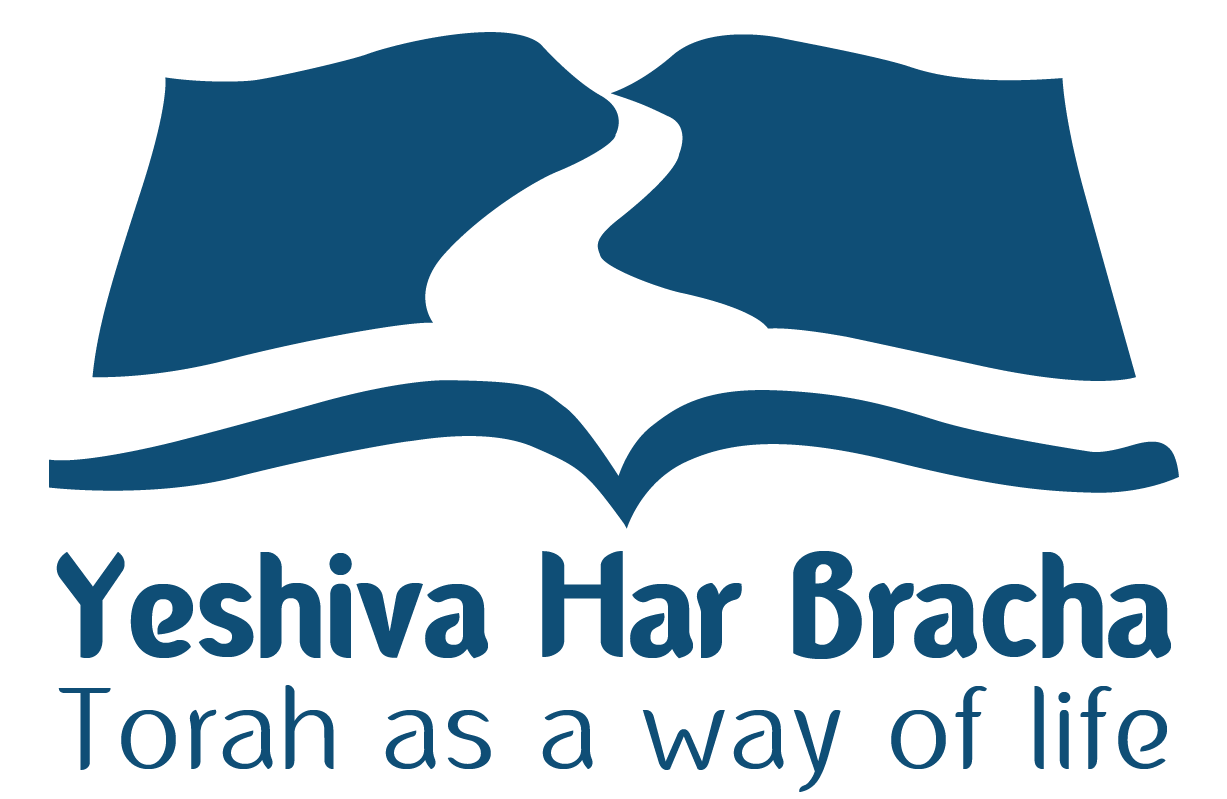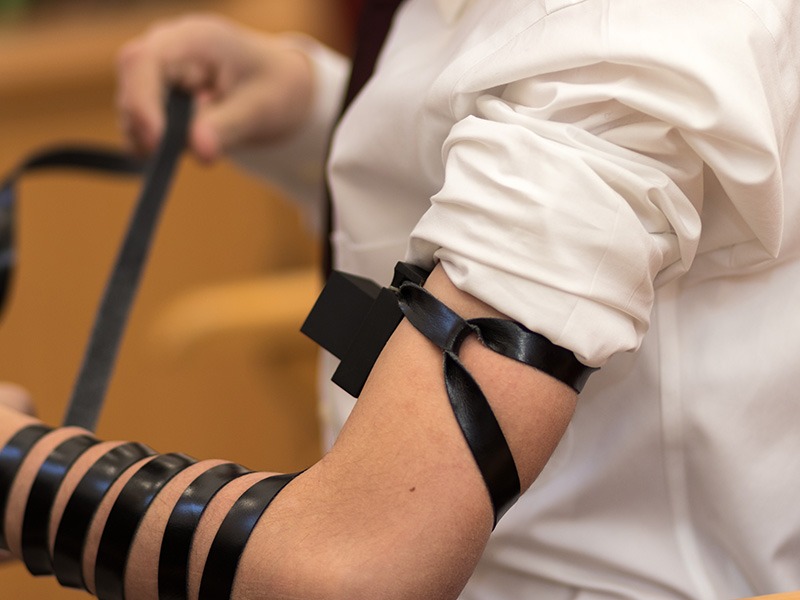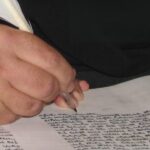It is a positive commandment from the Torah to bind tefillin of the hand on the arm every day * An additional commandment to bind tefillin of the head, on the head between the eyes * The place of tefillin of the hand is on the bulging muscle of the arm with a slight inclination inward toward the heart * The place of placing tefillin of the head is from the beginning of the place where the hair of the head grows above the forehead, until the spot where a baby’s brain is soft * One must aim the tefillin to be in the middle of the head, opposite between the eyes * One who has become bald over many years may place them on the place where his hair grew when he was young
The Commandment of Tefillin
This Shabbat we read Parashat ‘Va’etchanan‘ the portion of “Shema,” in which appears the commandment of tefillin, as it is said: “Hear O Israel, the Lord our God, the Lord is One. And you shall love the Lord your God with all your heart and with all your soul and with all your might. And these words which I command you today shall be upon your heart… And you shall bind them as a sign upon your hand, and they shall be as frontlets between your eyes” (Deuteronomy 6:4-8). Therefore, I will deal with the commandment of tefillin, while focusing on the laws of the place of tefillin.
It is a positive commandment from the Torah to bind tefillin of the hand on the arm every day, and an additional commandment to bind tefillin of the head on the head opposite between the eyes, in order to always remember the foundations of faith. In tefillin, are placed four portions in which appears the commandment to place tefillin, and these are: “Kadesh” (Exodus 13:1-10), “Ve-haya ki yevi’acha” (Exodus 13:11-16), “Shema” (Deuteronomy 6:4-9), “Ve-haya im shamoa” (Deuteronomy 11:13-21).
Content of the Tefillin Portions
In these four portions are mentioned the principles of Israel’s faith and Torah. In the first two portions is explained the matter of the sanctity of firstborn, the Land of Israel, the Exodus from Egypt and Passover, expressing the holiness and special status of Israel, for which reason the Lord brought us out of Egypt with signs and wonders, and through this, it was revealed to us, and to the entire world, that the Lord oversees the entire world, and everything is in His hands. Since the Exodus from Egypt is the foundation of Israel’s faith, in these portions was also given the commandment to observe Passover, and to tell the children on the night of the Seder the story of the Exodus from Egypt.
In the last two portions of the tefillin are explained the foundations of Israel’s faith and their destiny. In the portion of ‘Shema‘ appear the fundamental commandments incumbent upon each and every individual, the belief in the unity of God and love of Him with all the heart and soul, and the commandment to meditate on Torah at all times, when we lie down and when we rise up, at home and on the way, and to pass it on to our children after us. In the last portion is explained the great destiny of the people of Israel to inherit the good Land, and to fulfill in it all the commandments, and to benefit from the divine blessing. Also explained in it is the principle of reward and punishment, that God oversees Israel, and if we sin – we will be lost from the good Land, and if we hearken to the voice of God, we will be blessed, and will lengthen our days on the Land which God swore to our forefathers.
Place of Tefillin of the Hand
The place of tefillin of the hand is on the bulging muscle of the arm with a slight inclination inward toward the heart. As it is said in the portion of “Shema“: “And you shall bind them as a sign upon your hand” (Deuteronomy 6:8), and likewise it is said in the portion of “ Ve-haya im shamoa “: “And you shall place these words of Mine upon your heart and upon your soul, and bind them as a sign upon your hand” (Deuteronomy 11:18). From this, our Sages learned (Menachot 37b) that one must place the tefillin in the highest place on the arm, which is on the place of the muscle mass, namely, the protruding muscle between the shoulder and the elbow. In addition to this, it is said to place the tefillin “upon your heart,” that is, on the muscle of the arm that is opposite the heart. We also learned from this that it is proper to incline the tefillin slightly toward the heart, but one should not over- incline, because then, the tefillin will not be on the muscle.
As a reason for the commandment, it is possible to say that binding tefillin of the hand is intended to hint to us two things. One, that above all the mighty deeds that a person does with his hands and with his muscles, stands the faith in the One who gave us the strength to do all this might. The second, that the heart, with all its emotional power, must be directed and guided by the Torah, therefore we place the tefillin on the muscle of the arm, and opposite the heart.
Must it be Specifically on the Lower Half of the Bone?
Rabbenu Peretz wrote that not every place of the muscle is fit for tefillin, but only the place of the muscle that is found on the lower half of the bone, between the elbow and the shoulder. And so it is ruled in the Shulchan Aruch and in the Rema (Orach Chaim 27:1, 7), that the tefillin must be on the lower half of the bone. And so wrote many later authorities (Levush, Magen Avraham, Shulchan Aruch HaRav, Artzot HaChaim). And there are those who hold that even be-di’avad (after the fact), if one cannot place on the lower half and places on the upper half – he should not bless (Chayei Adam 14:10; Yechaveh Da’at 5:3).
However, this is very difficult. First, because the other early authorities who preceded Rabbenu Peretz did not mention this matter, but only that the place of tefillin is on the muscle mass. Also, our Sages said that the tefillin must be opposite the heart, and the heart is not found opposite the lower half of the arm, but opposite the middle of the arm, or slightly higher. Moreover, Rabbenu Peretz wrote his words simply without explaining the source of his chidush (innovation), and our Sages also said that there is a place on the arm to place two tefillin, and according to Rabbenu Peretz, there is no place for that there. And finally, among young boys, the lower half is outside the muscle, and according to the plain meaning of the Gemara and most poskim (Jewish law arbiters), there is an obligation to place the tefillin on the place of the muscle.
Explanation That There is No Disagreement
It is possible to say that Rabbenu Peretz intended to explain the understood and agreed upon, and since he did not see this as a chidush, he did not need to justify his words. And his intention is that the place of the muscle mass is in the lower half of the entire bone, namely, the bone that extends from the shoulder to the elbow. And the place of the muscle mass when the arm is straight, which is its comfortable position of the arm, and then the place of the muscle is longer (Orach Mishpat 4). And one should not argue that one needs to calculate the bone from the armpit, for when one raises the arm, the same measurement results between the elbow and the center of the armpit. In this way, it turns out that the main place of the muscle mass is in the lower half, and opposite the heart. This resolves the main difficulties on Rabbenu Peretz. However, it is still difficult that there is a little place of muscle above the upper half, and it is possible that he did not intend to calculate the bone precisely, but to explain that generally speaking, it is the lower half.
The Halakha in Practice
However, there were those who did not interpret the position of Rabbenu Peretz this way, and because of all the difficulties on his position, they ruled that one should not consider his opinion at all (Gra 27:1; Ma’aseh Rav, Tefillin 21). For the practical halakha, the opinion of most later authorities is that the main thing is that the place of tefillin is on the muscle, and even though le-chatchila (optimally) one should take the opinion of Rabbenu Peretz into consideration and place on the lower half, one who has difficulty placing the tefillin on the lower half, because he has a wound there, or because he is young and his arm is short and his tefillin are large, should place the tefillin with a blessing on the place of the muscle, even above the lower half of the bone (Ha’emek She’elah 145:3; Mishnah Berurah 4; Ben Ish Chai, Chayei Sarah 6, and many others).
Place of Tefillin of the Head
The place of placing tefillin of the head is from the beginning of the place where the hair of the head grows above the forehead, until the place where a baby’s brain is soft, namely, the end of the soft spot in a baby’s head. And one must aim the tefillin to be in the center of the head facing between the eyes (Shulchan Aruch 27:9-10). If the tefillin are not aimed precisely in the middle of the head, but have moved slightly right or left, as long as they are placed opposite between the eyes – they are still in their place. Therefore, there is no need to use a mirror to aim them precisely, but it is sufficient to aim them by feeling with the hand (Divrei Chaim 2:6; Tzitz Eliezer 12:6:2).
All the Tefillin on the Place of Hair Growth
One must be careful that even a portion of the tefillin should not be below the place where the hair of the head grows toward the forehead, because according to many opinions, even if a little of the tefillin is placed opposite the forehead – he has not fulfilled the commandment, and his blessing is in vain. Since the shape of the head is slightly round, and the bottom of the tefillin is straight, it turns out that the edge of the tefillin does not actually touch the place of hair growth, and therefore, one must check opposite where the tefillin are placed, and if even a little of them is placed beyond the place of hair growth – they are not in their place, and he has not fulfilled the commandment. One who has become bald over many years may place them on the place where his hair grew when he was young, for the main determining factor is the place of their growth according to what is usual among most people.
What is the Stringency About
Some say that only the box itself (the “ketzitzah“) needs to be on the place of hair, while the base, or wider part of the tefillin box (the “titora“) may be positioned against the forehead (Olat Tamid 27:8, Taz according to Beit Ya’akov). However, many interpreted that also the “titora” needs to be above the place of hair (Responsa Beit Ya’akov 131; Ma’amar Mordechai 27:8; Pri Megadim Mishbetzot Zahav 27:10; Shvilei David 27:4; Imrei Yosher Chadashot 3; Mishnah Berurah 27:33; Yechaveh Da’at 5:3). Rabbi Kook in his youth wrote the booklet ‘Chavash Pe’er’ in order to strongly reinforce the obligation that also the “titora” should be on the place of hair growth, and since one who does not practice this way loses the commandment and blesses in vain, one should point this out to him.
Those who Hold that it is Sufficient that Most of the Tefillin be on the Place of Hair
However, there were those who practiced placing part of the tefillin outside the place of hair growth, as was testified for example about the Rebbes of Belz. Three sides to this: 1) There are poskim like the Taz and Olat Tamid that the “titora” does not need to be on the place of hair growth. And so wrote Torat Chaim Sofer (27:10). 2) Some say that it is sufficient that most of the box be above the place of hair growth (Tiferet Ziv 1:1; Davar Yehoshua 4:11). 3) Some say that whatever is in the air is not considered, and it is sufficient that the part that touches the head be on the place of hair growth (Davar Yehoshua there; Omer V’Da’at 1). And some ruled le-chatchila to be stringent according to the opinion of the stringent poskim, except that they found merit for the lenient ones with these reasonings, and therefore ruled not to point it out to them (Da’at Kedoshim 27:9; Machshavot B’Etzah 1).
The Practical Halakha that All the Tefillin Should be on the Place of Hair
In practice, since it is the opinion of many that all the tefillin need to be on the place of hair, and if even some of them are not on the place of hair, he has not fulfilled the commandment and his blessing is in vain, one should be stringent and careful about this. Since every day one tightens the strap around the head, the strap stretches and lengthens from the knot, and the tefillin tend to slip toward the forehead. Therefore, one must check the condition of the straps once every half year, or year. As a rule, it is better that the strap be shorter, so that if it stretches a little, the tefillin will still be in their place (Mishnah Berurah 27:33).
This article appears in the ‘Besheva’ newspaper and was translated from Hebrew.








